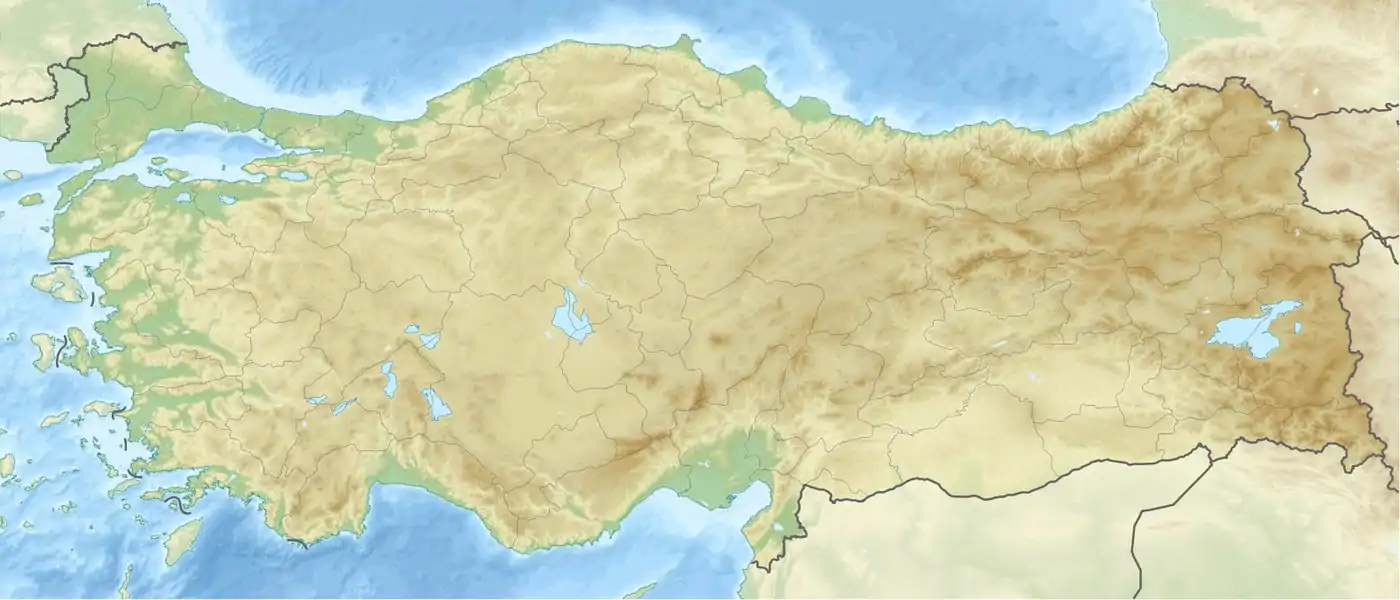1939 Erzincan earthquake
The 1939 Erzincan earthquake struck eastern Turkey at 1:57:23 a.m. on 27 December local time with a moment magnitude of 7.8 Mw and a maximum Mercalli intensity of XII (Extreme). This was one of the largest in a sequence of violent shocks to affect Turkey along the North Anatolian Fault between 1939 and 1999. Surface rupturing, with an horizontal displacement of up to 3.7 meters, occurred in a 360 km long segment of the North Anatolian Fault Zone.[4][5] The earthquake was the most severe natural loss of life in Turkey in the 20th century, with 32,968 dead,[5] and some 100,000 injured.[6]
 | |
| UTC time | 1939-12-26 23:57:23 |
|---|---|
| ISC event | 902291 |
| USGS-ANSS | ComCat |
| Local date | December 27, 1939 |
| Local time | 1:57:23 a.m. |
| Magnitude | 7.8 Mw [1] |
| Depth | 20 km (12 mi) [1] |
| Epicenter | 39.77°N 39.58°E [1] |
| Fault | North Anatolian Fault |
| Type | Strike-slip |
| Areas affected | Erzincan Province Turkey |
| Max. intensity | XII (Extreme) [2] |
| Tsunami | .53 m (1 ft 9 in) [3] |
| Casualties | 32,700–32,968 dead [3] 100,000 injured [3] |
Preface
The North Anatolian fault has been, and remains very active. Erzincan has been destroyed by earthquakes at least 11 times since 1,000 AD.[7] Between 1942 and 1967, there were six major earthquakes along the same fault, with three above 7 Mw.[5][8]
Earthquake
The shaking lasted for 52 seconds.[9] It resulted in a tsunami with heights of 1–3 m (3.3–9.8 ft) that hit the Black sea coast.[10]
Damage
Some 116,720 buildings were destroyed. Occurring in winter, it was difficult for aid to reach the affected areas.
Initially, the death toll was about 8,000 people. The next day, it was reported that it had risen to 20,000. An emergency rescue operation began. By January 5, almost 33,000 had died due to the earthquakes and to blizzard conditions, followed by heavy rains that caused floods.[11]
Aftermath
The total destruction of the earthquake prompted Turkey to adopt seismic building regulations.[12] So extensive was the damage to the city of Erzincan that its old site was entirely abandoned and a new settlement was founded a little further to the north.
References
- ISC (2015), ISC-GEM Global Instrumental Earthquake Catalogue (1900–2009), Version 2.0, International Seismological Centre
- National Geophysical Data Center / World Data Service (NGDC/WDS) (1972), Significant Earthquake Database, National Geophysical Data Center, NOAA, doi:10.7289/V5TD9V7K
- USGS (September 4, 2009), PAGER-CAT Earthquake Catalog, Version 2008_06.1, United States Geological Survey
- "Erzincan, Turkey, 1939 December 26 23:57 UTC, Magnitude 7.8". Historic Earthquakes. USGS.
- Gürsoy, Halil; Tatar, Orhan; Akpınar, Zafer; Polat, Ali; Mesci, Levent; Tunçer, Doğan (2013-04-01). "New observations on the 1939 Erzincan Earthquake surface rupture on the Kelkit Valley segment of the North Anatolian Fault Zone, Turkey". Journal of Geodynamics. SI : Tethyan Evolution and Active Tectonics in Anatolia dedicated in honour of Prof. Dr. Ali Koçyiğit’s retirement. 65: 259–271. doi:10.1016/j.jog.2012.06.002. ISSN 0264-3707.
- Gürsoy, H.; Akpınar, Z.; Tatar, O.; Koçbulut, F.; Sezen, T.F.; Mesci, B.L.; Polat, A.; Kavak, K.Ş.; Tunçer, D.; Yaman, S. (November 2006). "1939 Erzincan depremi yüzey kırığı haritalama çalışmaları (Reşadiye batısı - Koyulhisar arası): ilk gözlemlere ait bulgular" (PDF) (in Turkish). Dokuz Eylül Üniversitesi. pp. 2–4. Archived from the original (PDF) on 23 November 2009.
- HAÇİN, İlhan (March 2014). "1939 ERZİNCAN BÜYÜK DEPREMİ". Cumhuriyet Üniversitesi.
- "Major Turkish Earthquakes of the 20th Century". Buffalo, NY: MCEER. 2010. Retrieved 26 December 2012.
- "Erzincan depreminin 80.yıl dönümü! Büyük Erzincan depremi kaç şiddetinde oldu?". Sabah (in Turkish). 27 December 2019. Archived from the original on 27 December 2019. Retrieved 31 October 2020.
- "Tsunami Türkiye'yi de vurmuş". Hürriyet (in Turkish). Retrieved 2020-12-30.
- Ranguelov, Boyko. "The Erzincan 1939 Earthquake" (PDF). Second Balkan Geophysical Conference and Exhibition. Retrieved 26 December 2012.
- Reitherman, R. (2012). Earthquakes and Engineers: An International History. American Society of Civil Engineers. pp. 226–228. ISBN 978-0-7844-1071-4.
Further reading
- Yalciner, A. C.; Pelinovsky, E. N. (2004), "The Source Mechanism of 1939 Black Sea Tsunami", AGU Spring Meeting Abstracts, 2004: OS13A–06, Bibcode:2004AGUSMOS13A..06Y
External links
- The International Seismological Centre has a bibliography and/or authoritative data for this event.